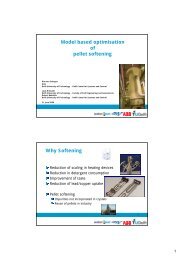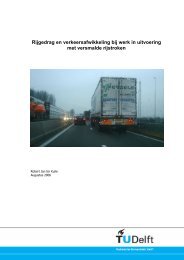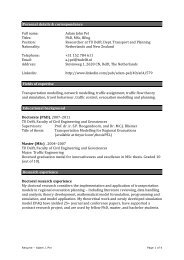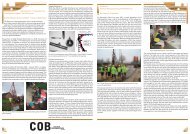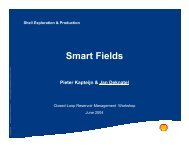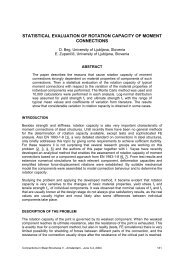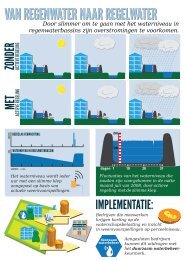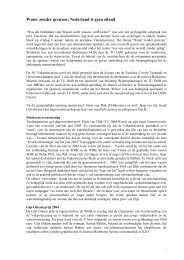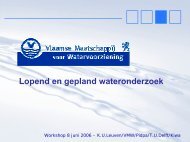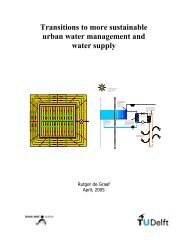Research on pedestrian traffic flow in the Netherlands - TU Delft
Research on pedestrian traffic flow in the Netherlands - TU Delft
Research on pedestrian traffic flow in the Netherlands - TU Delft
Create successful ePaper yourself
Turn your PDF publications into a flip-book with our unique Google optimized e-Paper software.
Daamen, W, & Hoogendoorn, SP (2003). <str<strong>on</strong>g>Research</str<strong>on</strong>g> <strong>on</strong> <strong>pedestrian</strong> <strong>traffic</strong> <strong>flow</strong>s <strong>in</strong> <strong>the</strong> Ne<strong>the</strong>rlands. In<br />
Proceed<strong>in</strong>gs Walk 21 IV (pp. 101-117). Portland, Oreg<strong>on</strong>, United States: Walk 21 c<strong>on</strong>ference.<br />
model parameters is d<strong>on</strong>e us<strong>in</strong>g a microscopic approach, where model results have been<br />
compared to observed microscopic <strong>pedestrian</strong> behavior (trajectories determ<strong>in</strong>ed from video).<br />
The user of <strong>the</strong> model is free to change <strong>the</strong> model parameters to best suit <strong>the</strong> <strong>pedestrian</strong><br />
behavior for <strong>the</strong> situati<strong>on</strong> at hand. For <strong>in</strong>stance, <strong>the</strong> effect of age, trip purpose, and gender of<br />
<strong>the</strong> walk<strong>in</strong>g speeds can be described. NOMAD automatically computes <strong>the</strong> effect of <strong>the</strong>se<br />
factors <strong>on</strong> <strong>the</strong> <strong>pedestrian</strong> walk<strong>in</strong>g speeds, based <strong>on</strong> results of empirical studies, such as<br />
reported by Weidmann (1993).<br />
Model structure<br />
Figure 4 depicts an overview of <strong>the</strong> NOMAD model, its <strong>in</strong>puts and outputs. The figure<br />
<strong>in</strong>dicates that <strong>the</strong> user of <strong>the</strong> model must provide <strong>the</strong> topology of <strong>the</strong> network (walls,<br />
obstacles, stairs, escalators, activity areas, etc.), <strong>the</strong> <strong>traffic</strong> demand patterns for each activity<br />
schedule, <strong>the</strong> parameters describ<strong>in</strong>g <strong>the</strong> walk<strong>in</strong>g behavior for each of <strong>the</strong> <strong>pedestrian</strong> types that<br />
are c<strong>on</strong>sidered (e.g. men, women, commuters, etc.), and f<strong>in</strong>ally <strong>the</strong> compositi<strong>on</strong> of <strong>the</strong><br />
<strong>pedestrian</strong> <strong>flow</strong> with respect to <strong>the</strong> <strong>pedestrian</strong> types. The latter describes <strong>the</strong> compositi<strong>on</strong> of<br />
<strong>the</strong> <strong>flow</strong> at <strong>the</strong> different orig<strong>in</strong>s <strong>in</strong> <strong>the</strong> model. F<strong>in</strong>ally, <strong>the</strong> user can def<strong>in</strong>e <strong>in</strong>cident c<strong>on</strong>diti<strong>on</strong>s,<br />
for <strong>in</strong>stance to simulate <strong>the</strong> effect of an evacuati<strong>on</strong>.<br />
Network topology<br />
Traffic demand<br />
per activity pattern<br />
DESTINATION +<br />
ROUTE CHOICE<br />
MODEL<br />
Special / <strong>in</strong>cident<br />
c<strong>on</strong>diti<strong>on</strong>s<br />
Compositi<strong>on</strong> of<br />
<strong>pedestrian</strong> <strong>flow</strong><br />
WALKER<br />
MODEL<br />
Walk<strong>in</strong>g<br />
parameters<br />
Output<br />
Figure 4. Comp<strong>on</strong>ents of <strong>the</strong> NOMAD model<br />
After <strong>the</strong> <strong>in</strong>put data be<strong>in</strong>g established, NOMAD first determ<strong>in</strong>es <strong>the</strong> dest<strong>in</strong>ati<strong>on</strong> and route<br />
choice. This is achieved by comput<strong>in</strong>g <strong>the</strong> m<strong>in</strong>imal route cost functi<strong>on</strong>, from which <strong>the</strong><br />
optimal walk<strong>in</strong>g directi<strong>on</strong>s are easily determ<strong>in</strong>ed. In turn, <strong>the</strong> walker model determ<strong>in</strong>es <strong>the</strong><br />
preferred walk<strong>in</strong>g directi<strong>on</strong> and speed us<strong>in</strong>g <strong>the</strong> m<strong>in</strong>imal route cost.<br />
The prevail<strong>in</strong>g <strong>traffic</strong> c<strong>on</strong>diti<strong>on</strong>s predicted by <strong>the</strong> walker model may cause delays to occur,<br />
for <strong>in</strong>stance upstream of narrow bottlenecks. In turn, deteriorati<strong>on</strong> of <strong>traffic</strong> c<strong>on</strong>diti<strong>on</strong>s may<br />
cause <strong>pedestrian</strong>s to choose a different route. NOMAD <strong>in</strong>hibits a feedback mechanism that<br />
111



